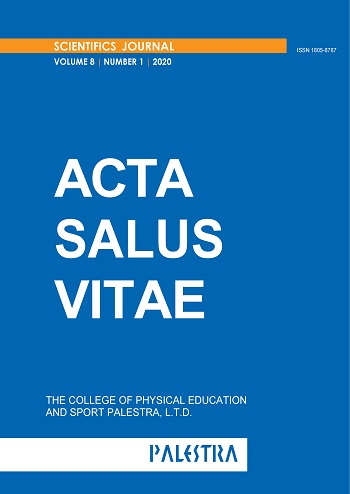Psychosocial benefits of the inclusive controlled physical activities in children and youth with intellectual disabilities
DOI:
https://doi.org/10.58743/asv2020vol8no1.210Keywords:
Controlled physical activities, Children, Intellectual disability, Integration, Sport activities, International project.Abstract
Background: The project was addressed to horizontal priority of the social inclusion in Programme “Erasmus +”, to actions that help address diversity and promote – in particular through innovative and integrated approaches – ownership of shared values, equality, including non-discrimination and social inclusion through education, training, youth and sport activities. Aim: The main goal of the presented paper is to present psychosocial benefits of the inclusive controlled physical activities in juvenile individuals with intellectual disabilities, applied in leisure time. Partial goal is to demonstrate types of the popular controlled activities for children and youth with intellectual disability in the participated countries of the project, i.e. Bulgaria, Czech Republic, Greece and Macedonia. The aim and all activities of the project are in accordance with EU Work Plans for Sport 2017-2020 with a focus on Priority 3: Sport and Society - Access to sport for people with disabilities. Methods: Battery of following methods was used - Content analysis of literary sources; Brustman tapping test; Bourdon proofreading - examination of the properties of attention; Emotional instability (model tremometry); Creativity Assessment Packet; Intervention “You are part of us”; for statistics the method of Qualitative Comparative Analysis was used. Results, discussion: Positive changes were observed in the measured of two measures of attention, i.e. “Attention in concentration” and the “Attention in switch ability”. Adaptation ability of the monitored samples has been improved. Conclusion: Emotional stability and ability to concentration has been improved.
References
Atherton, H., Crickmore, D. (2011). Learning disabilities: Toward Inclusion. 6th Ed. Leeds: Elsevier Health Sciences. 584 p.
Bartůňková, S. (2006). Fyziologie člověka a tělesných cvičení. [Physiology of human exercises] Prague: Karolinum. 285 p.
Bendíková, E. (2017). Theory of health, movement and lifestyle of human beings. Debrecen: University of Debrecen. 164 p.
Cureton, A., Wasserman, D. (2020). The Oxford handbook of philosophy and disability. London: Oxford University Press, 944 p.
DePauw, K.P., Gavron, S.J. (2005). Disability sport. Ed. 2nd. Champaign: Human Kinetics, 2005. 395 p.
Davis, R.W. (2011). Teaching disability sport: A guide for physical educators. 2nd Ed. Champaign: Human Kinetics, 2011. 280 p.
Eileen, K.A., Glynnis, E.C. (2015). The exceptional child inclusion in early childhood education. 8th ed. Boston: Cengage Learning. 624 p.
Fiedler, C.R., Simpson, R.L., Clark, D.M. (2007). Parents and families of children with disabilities: effective school-based support services. London: Pearson.
Forrest, D.J. (1990). The tremometer: a convenient device to measure postural tremor from lithium and other causes. The Journal of Neuropsychiatry Clinical Neurosciences. 2(4):391-4. doi: 10.1176/jnp.2.4.391.PMID: 2136391
Kornatovská, Z. (2017). The Impact of the intervention programme of controlled movement activities on the health and quality of life of Children with a sensory disability. Journal of Nursing, Social Studies, Public Health and Rehabilitation, 3(4), 136–145.
Kornatovská, Z. (2016). Physical therapy and health-social benefits of controlled physical activities in disability children, Physiotherapy, 22(1), 26-37.
Krejčí, M., & Kornatovská, Z. (2017). Yoga applications in persons with disabilities. In: E. Bolach, & A. Kawczynski (Eds.). Adaptacyjna aktywnoscz fizyczna. [Adapted physical activity]. Wroclaw: AWF, 104-127.
Kunchev, I. (2017). Коректурна проба на Бурдон – изследване свойствата на вниманието. [Bourdon proofreading - examination of the properties of attention] Blog.BG. Available at: http://kunchev.blog.bg/drugi/2017/10/28/korekturna-proba-na-burdon-izsledvane-svoistvata-na-vnimanie.1574542
Kudláček, M., Morgulec-Adamowicz, N., and J. Verellen. (2010). European standards in Adapted physical activity. Olomouc: Palacky University. 108 p.
Lepore, M., Gayle, G.M., Shawn, F.S. (2007) Adapted aquatics programming: A professional guide. 2. Ed. Champaign: Human Kinetics. 359 p.
Maheshwarananda, P.S. (2014). Jóga pro děti a mládež. [Yoga for children and youth]. Praha: Mladá fronta. 272 p.
Maheshwarananda, P.S. (2005). Yoga in Daily Life: The System. Vienna: Ibera Verlag. 272 p.
Mansell, J. & J. Beadle-Brown. (2010). Active support: enabling and empowering people with intellectual disabilities. London: Jessica Kingsley Publishers. 224 p.
Matson, J.L. (Ed.) (2019). Handbook of intellectual disabilities. Integrating theory, research, and practice. New York: Springer. 1114 p. eBook: doi 10.1007/0-387-32931-5.
Raglin, J.S., Wilson, G.S., and Galper, D. (2007). Exercise and Its Effects on Mental Health. In: Bouchard, C., Blair, S.N., Haskell, W.L. Physical activity and health. Champaign: Human Kinetics.
Rehor, P.R., Kornatovska, Z. (2013). Measuring of Health – related benefits of physical activity in high school students. Acta Salus Vitae, 1(2), 148-157.
Thomann, E., & Maggetti, M. (2020). Designing research with qualitative comparative analysis (QCA): Approaches, challenges, and tools. Sociological Methods & Research, 49(2), 356–386. https://doi.org/10.1177/0049124117729700.
Velemínský, M., Velemínský, M. jr. (2017). Dítě od početí do puberty. [Child from birth to puberty]. Prague: Triton. 480 p.
WHO (2017). Steps to health: a European framework to promote physical activity for health. Copenhagen: WHO Regional Office for Europe. Available at: euro.who.int/_data/assets/pdf_file/0020/101684/E901191.pdf.
Williams, F.E. (1980). Creativity Assessment Packet: (CAP). New York: D.O.K Publishers, Available at: https://www.rand.org/education-and-labor/projects/assessments/tool/1980/creativity-assessment-packet-the-williams-scale-cap.html.
Winnick, J.P., Porretta, D.L. (2020) Adapted physical education and sport. Ed. 6. London: Human Kinetics, 632 p.
Downloads
Published
How to Cite
Issue
Section
License
Copyright (c) 2020 Zuzana Kornatovská, PhD.,DiS., Slav Mgr. PETKOV, Panagiotis KORELLAS, Georgi KALAYDZHIEV PhD.

This work is licensed under a Creative Commons Attribution 4.0 International License.
Authors publishing in this journal agree to the following terms:
Authors retain copyright and grant the journal the right of first publication, while the work is also licensed under the Creative Commons Attribution License, which allows others to share this work acknowledging its author and initial publication in this journal.
Authors are permitted to enter into separate, additional contractual arrangements for the non-exclusive distribution of the work in the version published in the journal (for example, to publish it in a book), with an acknowledgement of its initial publication in this journal.
Authors are allowed and encouraged to share their work online (for example, on their websites) before and during the editorial process of their contribution, as such a practice can lead to productive exchanges of ideas and also earlier and higher citation of the published work (See the Open Access Effect).


